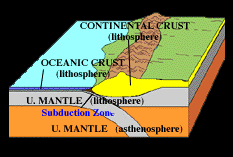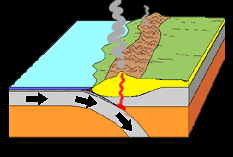 |
 |
WHEN OCEAN FLOOR AND CONTINENTS COLLIDE
 |
 |
Did you ever wonder what caused volcanoes like Mount St. Helens and Mt. Fuji to form?
In a word -- Subduction. Shishaldin
Unimak Island, Alaska
June 4, 1997
Summit EL.: 9373 ft.
Photo by U.S. NavyContinents float like giant icebergs atop the upper mantle. The uppermost mantle is composed of a rigid lithosphere and below it is a molten asthenosphere. The mantle lies so deep that there are very few places on earth where we can glimpse upthrust pieces of it, although some attempts have been made to drill into it from locations where earth's crust is very thin.
The upper lithosphere is also known as the earth's crust-- the cool, outer surface that we see.
There are two types of crust:
- 1)_oceanic crust (dark, heavy basaltic rock)
- 2)_continental crust (relatively lighter-colored and lighter-weight granitic rock).
Broken up into a number of distinct, moving tectonic plates, the lithosphere slides in constant slow- motion, driven by convection currents originating deep inside the earth which in turn causes lateral flow in the asthenosphere to drag the overlying lithosphere laterally with it. Where plate boundaries converge, this motion causes the lithosphere from one plate to be dragged beneath another, where it is melted and recycled. This process is called subduction.
This occurs generally in one of two ways:
Subduction and the forces associated with it can create spectacular mountain ranges. This is how the continuous mountain chain around the Pacific Ocean known as the "Ring of Fire" came to be-- a subduction zone creating magma chambers in the upper mantle, from the tip of South America north to the Cascade Mountains and the Aleutian Islands of Alaska, then running south through Japan, Southeast Asia, and continuing as far south as New Zealand.
When oceanic crust collides with continental crust, continental crust being less dense will usually ride up over the oceanic crust. As a result oceanic crust and the upper mantle lithosphere sink deep beneath the continent, becoming melted at some depth by the tremendous heat and pressure. Some of this molten rock or magma returns to the surface, melting some continental crust in the process, sometimes reaching the surface as volcanoes and lava flows. Mountain ranges are created from the formation of these deep magmas and the effects of volcano-building.
When continental crust collides with continental crust, however, something different happens. Because of their equal densities they simply smash into each other, bunching up. The highest mountain ranges on Earth are created when continents collide with continents, not so much from any resultant volcanic activity, but rather from direct crustal deformation resulting from the collision. Follow the link to see this in action.
The Pacific Ocean "Ring of Fire"
Source: U.S. Department of the Interior, U.S. Geological Survey.
Volcanoes can also form by other mechanisms besides subduction. There are spots on earth where stationary magma plumes burn like a welder's torch at plates moving over them, creating a string of volcanoes lined up in the direction of plate motion. The Hawaiian Islands were created this way.
Narrative and animation by:
Monte Hieb and Nancy Hieb
mhieb@geocraft.com